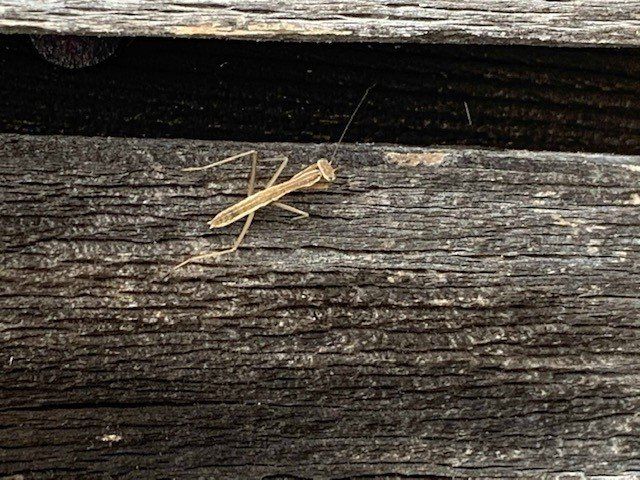Praying Mantis
This is my favorite insect – it has for as far as I can remember back into my childhood. Probably doesn’t hurt that they are green (my favorite color) – though they can also be brown. And I am not sure what it says about me to have a favorite insect where the female is known to eat the smaller male.
But, I have fond recollections of praying mantis because of my Nana. When we were young, my parents built her an apartment over the garage at our house. She had a deck full of plants – always a pot of marigolds to attract the bees away from her since she was highly allergic and always a hanging basket of fuchsia which attracted the hummingbirds. That was where I saw my first hummingbird – on her deck. She would also buy praying mantis egg cases. We would run a thread and needle through the case and then go around the yard hanging the egg cases in potted plants and shrubs with the hopes that the praying mantis would do their job – eating the other insects that lived to devour our vegetables and flowering plants. And, the fun thing about the praying mantis is that when they hatch, they come out as tiny miniature versions of their adult selves.
I have been buying and putting out the egg cases for years and I am happy now that I can share this with my seven-year-old son. This year, I ordered quite a few cases and we stitched a thread through and hung them around the yard. We decided to keep one egg case in a baby food jar (Yes, it’s a baby food jar that’s seven years old! I like to save and reuse) with a screen banded over the top so that we could see them hatch. The trick is you need to get them out quickly when they do hatch because in an enclosed space – or an area without the cases being spaced out – the babies will also resort to cannibalism.
The egg has been in our house since April and I had started to lose hope of anything happening until, as we were leaving (or we can say RUSHING) out the door this morning for camp, we realized that the babies had hatched. But, the rubber band on the screen had rotted and the babies found an opening where the screen had popped up! Thus, we didn’t just have praying mantis babies in the jar, they were all over my orchids and antique jars inches from our dog’s bed!
Thus ensued a madcap, crazy, fast, but careful attempt to gather them up individually and get them back into the jar to release outside! Do you want to know what it’s like to wrangle a hopping (not yet flying) tiny insect when there are up to 100 of them?! When they hatch they are only about half an inch long and here we were trying to grab them from pots and orchid roots without crushing them!
I think we managed to get most of them – my return home this evening will tell the tale. Just hoping they didn’t decide to go snuggle with Zevna – our Siberian Husky sleeping on her bed!
JNLF
Recent Posts





